

Goa. Fairs and Festivals in India. Ambassade. Ambassade er et lands offisielle representasjon i en fremmed stat, vanligvis ledet av en ambassadør eller chargé d'affaires ad interim og lokalisert i vertslandets hovedstad.

Ambassaden kan også være sideakkreditert fra en annen hovedstad. Det vil si at en ambassade er senderstatens representasjon i flere land. Ambassaden kan ha underliggende generalkonsulat, konsulat, visekonsulat eller andre spesielle representasjoner. En utenriksstasjon med betegnelsen legasjon er ikke en ambassade, men ledes av en minister som har rang lavere enn ambassadør. Historisk utvikling av ambassadebegrepet[rediger | rediger kilde] Uttrykket ambassade har gjennomgått en utvikling. Man hadde imidlertid også på den tid ofte også faste stedlige representanter, men de ble som oftest ikke kalt ambassadører. Etter Wienerkongressen opprettet de fem stormakter Frankrike, Storbritannia, Østerrike, Preussen og Russland, ambassader i hverandres hovedsteder. Andre lands ambassader i Norge[rediger | rediger kilde] Welcome to Embassy of India - Oslo, Norway. Norway - the official site in India. India. Koordinater: 22°55′05″N 78°34′27″Ø (kart) Republikken India (hindi: Bharat) er det største landet i Sør-Asia.
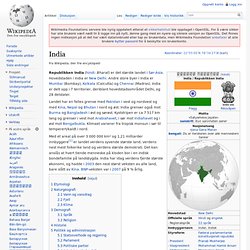
Hovedstaden i India er New Delhi. Andre store byer i India er Mumbai (Bombay), Kolkata (Calcutta) og Chennai (Madras). India er delt opp i 7 territorier, deriblant hovedstadsområdet Delhi, og 28 delstater. Landet har en felles grense med Pakistan i vest og nordvest og med Kina, Nepal og Bhutan i nord og øst.
Med et areal på over 3 000 000 km² og 1,21 milliarder innbyggere[1] er landet verdens syvende største land, verdens nest mest folkerike land og verdens største demokrati. Etymologi[rediger | rediger kilde] Navnet India er utledet av navnet på elva Indus. Punjab (India) Sett fra et historisk perspektiv utgjør den indiske Punjab en del av den større regionen Punjab, som inkluderer noen områder i Afghanistan, de pakistanske provinsene Punjab og Nordvestlige Grenseprovinsen (NVGP) og de indiske delstatene Haryana og Himachal Pradesh.
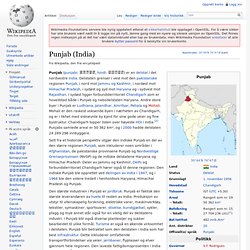
Deler av Jammu og Kashmir, Delhi og forbundsterritoriet Chandigarh hører også til denne regionen. Den indiske Punjab ble opprettet ved delingen av India i 1947, og i 1966 ble den videre tredelt i henholdsvis Haryana, Himachal Pradesh og Punjab. Jalandhar (distrikt) Welcome to Official Website of Jalandhar District, Punjab. Sightseeing in Punjab - Places to Visit in Punjab - Sightseeing Places in Punjab. Tourism in Punjab, India. The Indian state of Punjab is known for its cuisine, culture and history.
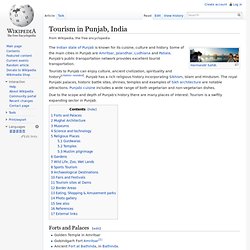
Some of the main cities in Punjab are Amritsar, Jalandhar, Ludhiana and Patiala. Punjab's public transportation network provides excellent tourist transportation. Tourists to Punjab can enjoy culture, ancient civilization, spirituality and history[citation needed]. Punjab has a rich religious history incorporating Sikhism, Islam and Hinduism. Places to Visit in Punjab: Check out 91 Punjab Things to Do. Punjab Sightseeing, Punjab Attractions. Tourist Places to Visit in Punjab HolidayIQ Home › India › Punjab › Tourist Places in Punjab Check out the destinations where your friends have been to .

Punjab travel guide. Punjab (Punjabi: ਪੰਜਾਬ; IPA: [pəɲdʒaːb])is a state in the northwestern part of The Republic of India.

When India was divided, the region was divided along religious grounds. Consequently, the western portion became a province in Pakistan. Located in northern part of India it borders Himachal Pradesh and Jammu and Kashmir to north-east and north and Chandigarh,Haryana and Rajasthan towards south-east , south and south-west. Punjab Sikhism is the main religion and is practiced by majority of the population, The holiest of Sikh shrines, the Golden Temple is located here. The most common language spoken is Punjabi (Gurumukhi script). Golden Temple. Kila Raipur Sports Festival. Competition is held for major Punjabi rural sports, include cart-race, rope pulling.

In February each year, Ludhiana becomes the destination for hundreds of sports enthusiasts, including foreigners. They come to Kila Raipur to see the special breed of bullocks, camels, dogs, mules and other animals competing in competitive events. The most prestigious winners have attended. Delhi. Delhi (hindi: दिल्ली, punjabi: ਦਿੱਲੀ, urdu: دلی, IPA: [d̪ɪlːiː]) er Indias nest største storbyområde, etter Mumbai.
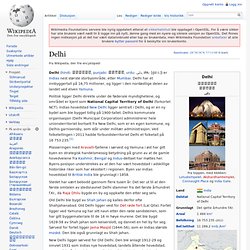
Delhi har et innbyggertall på 16,75 millioner, og ligger i den nordøstlige delen av landet ved elven Yamuna. Politisk ligger Delhi direkte under de føderale myndighetene, og området er kjent som National Capital Territory of Delhi (forkortet NCT). Indias hovedstad New Delhi ligger sentralt i Delhi, og er en ny bydel som ble bygget tidlig på 1900-tallet. Delhis kommunale organisasjon (Delhi Municipal Corporation) administrerer hele unionsterritoriet bortsett fra New Delhi, som er en egen kommune, og Delhis garnisonsby, som står under militær administrasjon. India - Globalis.no. India er et av verdens største og mest folkerike land, og en av verdens første avanserte sivilisasjoner oppsto i landet for mer enn 5000 år siden.
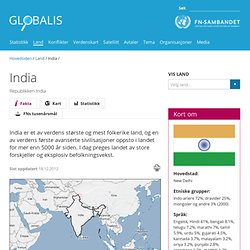
Maharashtra. Maharashtra (marathi: महाराषट्र, bokstavelig: Stor nasjon) er Indias tredje største delstat etter areal og den nest største etter folketall.
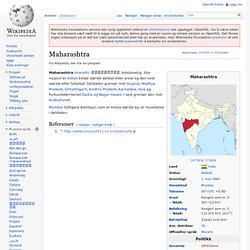
Mumbai. Mumbai (Marathi: मुंबई), tidligere kjent som Bombay, er delstatshovedstad i Maharashtra, og den mest befolkningsrike byen i India med en anslått befolkning i 2007 på ca. 19 millioner.[1]]. Byen ligger på øya Salsette utenfor vestkysten av Maharashtra. Sammen med sine forsteder på fastlandet utgjør Mumbai verdens 5. største storbyområde med en befolkning på ca. 20 millioner. India. India. The World Factbook. Location: This entry identifies the country's regional location, neighboring countries, and adjacent bodies of water. Southern Asia, between China and India Geographic coordinates: This entry includes rounded latitude and longitude figures for the centroid or center point of a country expressed in degrees and minutes; it is based on the locations provided in the Geographic Names Server (GNS), maintained by the National Geospatial-Intelligence Agency on behalf of the US Board on Geographic Names.
Map references: This entry includes the name of the Factbook reference map on which a country may be found. Note that boundary representations on these maps are not necessarily authoritative. The entry on Geographic coordinates may be helpful in finding some smaller countries. Area: This entry includes three subfields. Incredible India.
India country profile - Overview. India is the world's largest democracy and according to UN estimates, its population is expected to overtake China's in 2028 to become the world's most populous nation. As a rising economic powerhouse and nuclear-armed state, India has emerged as an important regional power. But it is also tackling huge, social, economic and environmental problems. Home to some of the world' s most ancient surviving civilizations, the Indian subcontinent - from the mountainous Afghan frontier to the jungles of Burma - is both vast and diverse in terms of its people, language and cultural traditions. See India in picturesSee more country profiles - Profiles compiled by BBC Monitoring Population 1.3 billion Area 3.1 million sq km (1.2 million sq miles), excluding Kashmir Major languages Hindi, English and more than 20 other official languages Major religions Hinduism, Islam, Christianity, Sikhism, Buddhism Life expectancy 67 years (men), 70 years (women) Currency Rupee Getty Images Read full biography.
History of India. The history of India begins with evidence of human activity of Homo sapiens, as long as 75,000 years ago, or with earlier hominids including Homo erectus from about 500,000 years ago.[1] The Indus Valley Civilization, which spread and flourished in the northwestern part of the Indian subcontinent from c. 3300 to 1300 BCE in present-day Pakistan and northwest India, was the first major civilization in South Asia.[2] A sophisticated and technologically advanced urban culture developed in the Mature Harappan period, from 2600 to 1900 BCE.[3] This civilization collapsed at the start of the second millennium BCE and was later followed by the Iron Age Vedic Civilization, which extended over much of the Indo-Gangetic plain and which witness the rise of major polities known as the Mahajanapadas.
In one of these kingdoms, Magadha, Mahavira and Gautama Buddha were born in the 6th or 5th century BCE and propagated their Shramanic philosophies. Prehistoric era[edit] Stone Age[edit] Bronze Age[edit] Indus Valley Civilization. The major sites of the Indus Valley Civilization imposed over modern borders The Indus Valley Civilization (IVC) was a Bronze Age civilization (3300–1300 BCE; mature period 2600–1900 BCE) extending from what today is northeast Afghanistan to Pakistan and northwest India (see map). Along with Ancient Egypt and Mesopotamia, it was one of three early civilizations of the Old World, and the most widespread among them, covering an area of 1.25 million km2.[3] It flourished in the basins of the Indus River, one of the major rivers of Asia, and the now dried up Sarasvati River,[4][5] which once coursed through northwest India and eastern Pakistan together with its tributaries flowed along a channel, presently identified as that of the Ghaggar-Hakra River on the basis of various scientific studies.[7][8][9] The Harappan language is not directly attested and its affiliation is uncertain since the Indus script is still undeciphered.
Vedic period. Maurya Empire. The Maurya Empire was a geographically extensive Iron Age historical power in ancient India, ruled by the Maurya dynasty from 322–185 BCE. Originating from the kingdom of Magadha in the Indo-Gangetic Plain (modern Bihar, eastern Uttar Pradesh) in the eastern side of the Indian subcontinent, the empire had its capital city at Pataliputra (modern Patna).[1][2] The Empire was founded in 322 BCE by Chandragupta Maurya, who had overthrown the Nanda Dynasty and rapidly expanded his power westwards across central and western India, taking advantage of the disruptions of local powers in the wake of the withdrawal westward by Alexander's Hellenic armies. By 316 BCE the empire had fully occupied Northwestern India, defeating and conquering the satraps left by Alexander.[3] Chandragupta then defeated the invasion led by Seleucus I, a Macedonian general from Alexander's army, gaining additional territory west of the Indus River.[4] History[edit] Chandragupta Maurya and Chanakya[edit]
Gupta Empire. The high points of this cultural creativity are magnificent architecture, sculptures and paintings.[7] The Gupta period produced scholars such as Kalidasa, Aryabhata, Varahamihira, Vishnu Sharma and Vatsyayana who made great advancements in many academic fields.[8][9] Science and political administration reached new heights during the Gupta era.[10] Strong trade ties also made the region an important cultural center and set the region up as a base that would influence nearby kingdoms and regions in Burma, Sri Lanka, and Southeast Asia.[11] The earliest available Indian epics are also thought to have been written around this period. Middle kingdoms of India. Gurjara-Pratihara. The Gurjar Pratihara (गुर्जर-प्रतिहार), often simply called Pratihara Empire, was an imperial Indian dynasty that ruled much of Northern India from the 8th to the 11th centuries. At its peak of prosperity and power (c. 836–910), the Gurajara-Pratihara Empire rivaled or even exceeded the Gupta Empire in the extent of its territory.
The Pratihara Empire started to decline in the early 10th century after it had to face several invasions by the south Indian Rashtrakuta dynasty.[1] Kannauj was the capital of imperial Gurjara Pratiharas.[2][3][4] The Gurjara Pratihara rulers in the tenth century was entitled as Maharajadhiraja of Āryāvarta ("Great King over Kings of the abode of the Aryans". i.e. Lords of Northern India).[5][6] Etymology[edit] The word "Pratihara" means protector or "who takes over the enemy/opponent" and was used by the Gurjara-Pratihara rulers as self-designation.
Pala Empire. Rashtrakuta Dynasty. A stanza from the 9th century Kannada classic Kavirajamarga, praising the people for their literary skills Rashtrakuta (Kannada: ರಾಷ್ಟ್ರಕೂಟ, Sanskrit: राष्ट्रकूट rāṣṭrakūṭa), was a royal dynasty ruling large parts of the Indian Subcontinent between the sixth and the 10th centuries. The earliest known Rashtrakuta inscription is a 7th-century copper plate grant that mentions their rule from Manpur in the Malwa region of modern Madhya Pradesh. Company rule in India. British Raj.
Geography of India. Culture of India. Indian religions. Jainism. Buddhism. Hinduism. Sikhism. SinghSahib.com : Sikh Gurus ~ Sikhism ~ Sikhs : Nitnem, Shabad Kirtan, Sukhmani Sahib, Sikh History, Picture Gallery, Sikh Baby Names. Welcome to website about history of the sikhs. Etiquette of Indian dining.